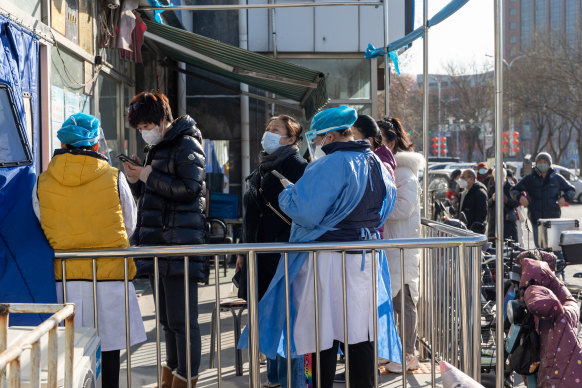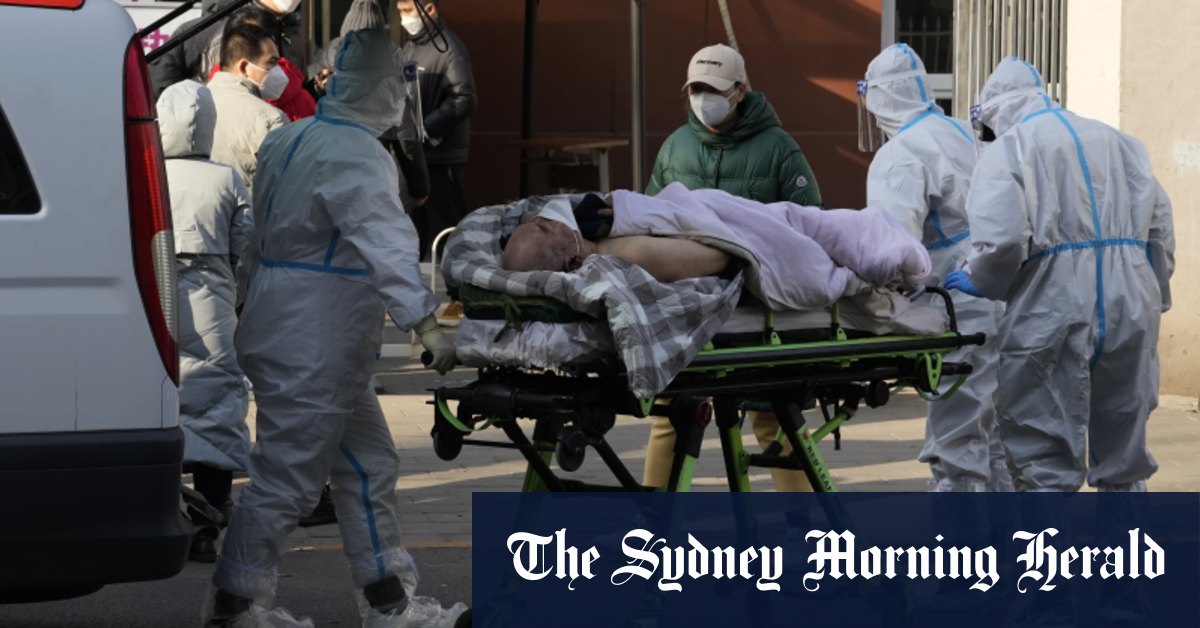A May study by Fudan University found that if restrictions were lifted, there would be 112 million symptomatic cases, 2.7 million intensive care unit (ICU) admissions and 1.6 million deaths. It is estimated that Immunization coverage has improved since then, but he is only 67% of her 264 million people over the age of 60, which is not enough in a country that is fully vaccinated.
“This will lead to a surge in cases,” said Dr. Leong Hoe Nam, an infectious disease specialist at the Rophi Clinic in Singapore. “Particularly in under-vaccinated populations where less effective vaccines such as inactivated vaccines are used.”
An elderly man was taken to a fever clinic in a Beijing hospital on Friday.credit:APs
More than 80% of the elderly received two doses of the Chinese inactivated vaccine Sinovac and Sinopharm vaccine, and clinical trial data showed that after two doses, the protection against symptomatic disease was 51%. ~ 79%, and 90% in the US and Europe. mRNA vaccines such as Pfizer and Moderna. A Hong Kong study found that his three doses of the Chinese-made vaccine boosted his effectiveness in preventing serious illness by up to 90%, but boosters in people over the age of 80 He was only 40%.
The National Health Board is now rolling out a door-to-door vaccine campaign, but persistent skepticism remains. Officials hope the Omicron strain is less severe than previous variants. They made that message a key component of the huge narrative shift that has moved like a whiplash through China’s state media over the past week. , spelled death and destruction. By December, despite better healthcare systems in the United States and Australia, it was no worse than the common cold.
Leon is not convinced.
“Unfortunately, procrastinating on vaccination and opening up is a double blow,” he says.

Beijing residents are waiting to be tested for COVID-19 on Thursday. credit:Sangy Liu
“An inadequately vaccinated population and cold winter months will lead to an unprecedented number of COVID cases in China. We were forced to do it now instead. This is the worst time to fight COVID.”
Chinese hospitals are unprepared for the wave that is about to break. There are only an estimated 3.6 ICU beds per 100,000 people, compared to 11.4 in Singapore or 9.1 in Australia.
China’s huge manufacturing capacity means it can quickly expand its supply of equipment, but it faces shortfalls on two fronts.
In previous outbreaks, doctors from the community were called in to assist staff at major crisis centers. “But now every doctor has to fight the fire in his own hospital,” he said. “No reinforcements coming”
Second, the government has not taken the time to adequately train ICU nursing professionals in the COVID-09 era. “It takes a long time to train competent ICU medical workers,” says Leong. “Hardware without the software to run it is still useless.”
Leon describes the prognosis as “horribly bleak.”
Until last week, 90% of vaccinated youth in China paid the price to keep unvaccinated elderly safe. Now their roles are reversed. Old people die to keep the economy going.
“The Chinese economy will no longer survive if the lockdown is not lifted,” said Chu, a construction worker.
“If the coronavirus measures continue until the second half of next year, our store will go bankrupt,” Jin said.
Dr. Yan Long, an expert in health politics and sociology at the University of California, Berkeley, said the economic crisis had pushed young Chinese workers into the wall.
“The younger generation faces a very different future. [to their parents]’ she said Zheng Fowei Thursday’s China Political Forum. “Protesters have found a common outlet.”
Children are playing in Beijing while their parents pick up supplies from pharmacies. credit:Sangy Liu
So did local governments, frustrated at putting the economic burden of zero coronavirus on the central government, and forced Beijing’s hand much sooner than many expected.
“I think the local governments probably used the protests as a bargaining chip against the central government.
“They used [the protests] All right, tell the central government that this is the limit and that we can’t do that anymore.”
For the open-minded Communist Party of China and its leader, Xi Jinping, optics are a challenge.
Loading
“This wave of protests came less than two months after the party convention, which is a major blow to the legitimacy of the current regime domestically and internationally,” Yang said .
The population endured what French philosopher Michel Foucault called “biopolitics” for three years, in effect, a condition in which their bodies became docile to a never-ending cycle of politically-driven COVID-compliance.
“Even children automatically open their mouths whenever they see a big white thing,” Yang said, referring to COVID officials in hazmat suits.
“But even with all this effort, we now see people’s desire for agency, autonomy, and freedom. I think it’s an incredibly strong signal for the administration of
In the first two months of the pandemic, Wuhan doctor Li Wenliang repeatedly tried to warn Chinese authorities about a “mysterious pneumonia” that was overwhelming the local health system. Lee died of his COVID in February 2020 at the age of 33. A month after he was punished for “spreading rumors,” and two weeks after he was put under lockdown in Wuhan, China plunged into his three darkest years.
On Thursday, residents posted on Weibo’s tribute page.
“Three years, Dr. Lee, do you know? We’ve finally dawned.
Get notes directly from our expats correspondent About what is making headlines around the world. Sign up for our weekly What in the World newsletter here.
https://www.smh.com.au/world/asia/china-s-covid-numbers-are-about-to-explode-experts-say-it-s-not-ready-20221208-p5c4nk.html?ref=rss&utm_medium=rss&utm_source=rss_world China COVID cases rise as Beijing prepares for winter surge
